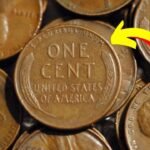Most of us seldom consider the value of the spare change jingling in our pockets. However, imagine if one of those coins turned out to be a fortune in disguise. Surprisingly, a Rare Bicentennial Quarter has been appraised at an astonishing $11 million! While the majority of these quarters are worth just 25 cents, a select few have achieved legendary status among coin collectors.
In 1975 and 1976, to honor the 200th anniversary of the United States’ independence, the U.S. Mint introduced a special edition quarter. Departing from the traditional eagle design on the reverse, these quarters showcased a colonial drummer accompanied by the dual dates “1776-1976.” This commemorative release captured the nation’s enthusiasm, and millions of Americans encountered these distinctive quarters in their daily transactions.
However, not all Bicentennial Quarters are identical. While most serve as mere pocket change, certain rare variants have captivated the numismatic community, fetching prices that reach into the millions.
Factors Contributing to the Quarter’s Extraordinary Value
How can a coin with a face value of 25 cents escalate to a worth of $11 million? The answer lies in a combination of rarity, minting anomalies, composition, and condition. Let’s explore the critical factors that contribute to the immense value of some Bicentennial Quarters.
- Minting Anomalies Errors during the minting process can render a coin exceptionally rare and desirable among collectors. Some of the most sought-after Bicentennial Quarters exhibit anomalies such as:
- Double Strikes: Coins struck multiple times by the die, resulting in overlapping images.
- Off-Center Strikes: Coins misaligned during production, leading to a skewed design.
- Struck-Through Errors: Instances where foreign materials interfere during striking, leaving distinctive impressions on the coin.
- Die Cracks: Fissures in the die that imprint unique patterns on the coin’s surface.
- Silver Content While the majority of Bicentennial Quarters were minted using a copper-nickel composition, a limited number were produced with 40% silver content. These silver variants were primarily included in special collector’s sets. The most coveted among them are those mistakenly struck in 90% silver, a composition intended solely for proof coins. This unintentional use of a higher silver content renders these quarters exceedingly rare.
- Pristine Condition: Mint State and Proof Coins The condition of a coin is paramount in determining its value. Bicentennial Quarters in Mint State (MS) grades of 67 or higher are considered virtually flawless, having never been in circulation. Proof coins, characterized by their sharp details and mirror-like finishes, are also highly prized. Achieving such pristine conditions is uncommon, making these coins particularly valuable.
- Historical Significance Commemorating America’s 200th year of independence, the Bicentennial Quarter holds substantial historical importance. This significance, coupled with rare features like minting errors or unique compositions, elevates the coin’s desirability among collectors. A quarter that amalgamates these elements becomes a numismatic treasure, justifying valuations as high as $11 million.
Identifying a Rare Bicentennial Quarter
The pressing question remains: Could you unknowingly possess one of these rare Bicentennial Quarters? Here’s a comprehensive guide to help you determine if you have a valuable specimen:
- Examine the Date and Design Ensure your quarter bears the dual date “1776-1976” and features the colonial drummer on the reverse side. This design is unique to the Bicentennial edition.
- Identify the Mint Mark Locate the mint mark on the obverse side, adjacent to George Washington’s ponytail. The marks indicate the following mints:
- No Mint Mark: Philadelphia Mint
- D: Denver Mint
- S: San Francisco Mint (often associated with proof and silver coins)
- Inspect for Minting Anomalies Utilize a magnifying glass to scrutinize your quarter for any irregularities such as double strikes, off-center designs, or die cracks. These anomalies can substantially enhance the coin’s value.
- Assess the Coin’s Composition Silver quarters possess a solid silver-colored edge, whereas copper-nickel coins display a distinct copper stripe along the edge. Additionally, weighing the coin can provide clues:
- Copper-Nickel Clad Quarters: Approximately 5.67 grams
- Silver Quarters: Approximately 5.75 grams
- Seek Professional Evaluation If preliminary assessments suggest you might have a rare quarter, consult professional grading services such as the Professional Coin Grading Service (PCGS) or the Numismatic Guaranty Corporation (NGC) for authentication and precise valuation.
Monetizing a Rare Bicentennial Quarter
Discovering that you own a valuable Bicentennial Quarter naturally leads to the question: Where can you sell it to realize its full worth? Here are some avenues to consider:
- Online Auction Platforms Websites like eBay, Heritage Auctions, and GreatCollections are popular destinations for rare coin collectors. These platforms often host competitive bidding, especially for highly sought-after coins like a Rare Bicentennial Quarter. Listing your coin with detailed photos, mint marks, and authentication documents can help attract serious buyers and drive up the final sale price.
- Reputable Coin Dealers Local and national coin dealers can offer immediate appraisals and may even purchase your coin on the spot. However, it’s essential to do your research—dealers vary widely in experience and reputation. Look for dealers affiliated with professional organizations such as the American Numismatic Association (ANA) to ensure you’re working with someone trustworthy.
- Coin Shows and Collector Conventions Large-scale coin shows bring together experienced collectors, investors, and dealers under one roof. Attending these events allows you to get multiple appraisals and connect with potential buyers who understand the true value of a Rare Bicentennial Quarter. These gatherings are often organized by reputable organizations and can offer unique networking opportunities.
- Numismatic Forums and Online Communities Online coin-collecting forums such as CoinTalk, The Coin Community Forum, and NGC’s Collector’s Society offer platforms where enthusiasts and experts share information and sometimes even buy and sell coins. These communities can offer honest feedback and direct access to collectors seeking rare pieces like your Rare Bicentennial Quarter.
- Auction Houses For exceptionally rare and high-value coins—especially those valued in the tens or hundreds of thousands—consider selling through a professional auction house. These institutions often handle the authentication, marketing, and bidding process. Some well-known examples include Stack’s Bowers Galleries and Goldberg Coins & Collectibles. They specialize in high-end numismatic items and have access to wealthy, serious collectors.
Other Rare Bicentennial Quarters Worth Thousands
While the $11 million Rare Bicentennial Quarter is a one-in-a-billion find, several other valuable variants are out there. These coins might not make you an instant millionaire, but they can still fetch hundreds or even thousands of dollars depending on rarity and condition.
- 40% Silver Bicentennial Quarters These quarters were included in special collector’s Mint Sets sold directly by the U.S. Mint. Composed of 40% silver rather than the typical copper-nickel blend, they are worth much more than face value, especially in pristine condition. A flawless example in MS-67 or higher can sell for several hundred dollars.
- Double Die Error Bicentennial Quarters Coins with doubled inscriptions or duplicated design elements due to a die error are highly prized by collectors. These errors often occur during the hubbing process, where the coin design is imprinted onto the die. Depending on the prominence of the doubling and the coin’s condition, these coins can fetch anywhere from $2,000 to $10,000 or more.
- Off-Center Strike Quarters A quarter that was struck off-center during the minting process can be quite valuable. The value generally depends on how off-center the strike is and whether key features, such as the date or mint mark, are still visible. A Rare Bicentennial Quarter with an off-center strike can sell for $1,000 to $5,000 or more.
- Struck on Wrong Planchet Errors On rare occasions, a Bicentennial Quarter may be struck on a planchet meant for another denomination, such as a nickel or a foreign coin. These rare errors can result in unique shapes, weights, and colorations, making them extremely collectible and valuable—often selling for tens of thousands of dollars if verified.
How to Protect and Preserve Your Rare Bicentennial Quarter
If you’re fortunate enough to own a Rare Bicentennial Quarter—or even suspect that you might—it’s crucial to protect it properly. Mishandling or improper storage can reduce its value dramatically.
- Avoid Touching the Coin Directly Oils from your fingers can damage the coin’s surface, especially on high-grade pieces. Always handle coins by their edges or use cotton gloves.
- Use Proper Coin Holders Store your coin in a professional-grade holder such as a 2×2 cardboard flip, a plastic snap case, or an airtight capsule. For coins of significant value, use third-party grading services that encapsulate the coin in a tamper-proof holder with an official grade.
- Store in a Controlled Environment Avoid exposing your coin to high humidity, extreme temperatures, or direct sunlight. A cool, dry place—preferably in a safe or lockbox—is ideal. Moisture can lead to tarnishing, especially for silver coins.
- Insure Your Collection If your Rare Bicentennial Quarter is genuinely valuable, consider insuring it under a collectibles or homeowner’s insurance policy. Document it with professional photographs and authentication papers.
Final Thoughts: Could You Be Sitting on a Hidden Treasure?
The Rare Bicentennial Quarter is more than just a piece of currency—it’s a slice of American history with the potential to change your financial future. Although most Bicentennial Quarters will only ever be worth 25 cents, a few rare examples have stunned the numismatic world by achieving prices that defy logic and expectation.
Some Important Link
| Telegram Group | Click Here |
| WhatsApp Group | Click Here |
| Home Page | Click Here |










